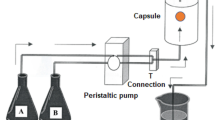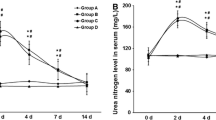Abstract
We compared the urothelial injury to the bladder caused by four agents capable of dissolving calcium salts. The solutions were administrated in an antegrade way through left ureterostomies in 54 rabbits for periods of 24, 48 and 72 h. The bladders were then removed and three routine histological sections were made for each. The following six solutions were used: physiological sodium chloride solution (Phys), artificial urine (Art), 0.03 M disodium EDTA buffered to pH 8.5 with triethanolamine (EDTA), 10% Renacidin (R), test solution 2 (S2, using D-gluconic acid-lactone and other compounds that differ from R in terms of ingredients or quantity), and test solution 1 (S1, using D-gluconic-acid instead of D-gluconic acid-lactone in S2 but keeping the other ingredients the same) for irrigation. At 24 h there was no observable urothelial damage caused by perfusion with Phys or Art; solutions R, S1 and S2 caused approximately the same level of injury to the rabbit bladder mucosa; however, irrigation with disodium-EDTA caused more serious urothelial injury than R, S1 and S2 (P<0.05, χ2-test) and may be unacceptable. The damage to bladder tissues treated with S1 and S2 was less than that caused by R, but this was not significant (P>0.05, χ2-test). Following a prolonged irrigation time, all of these solutions cause further urothelial damage, but EDTA caused the most, followed by R, S1, S2, Phys or Art, respectively, at 48 and 72 h. In view of the better solubility effect of solutions S1 and S2 compared with R, it might be justified in accepting the more pronounced urothelial irritation caused these solutions, but in order to enhance their effectiveness and reduce urothelial injury further study will be needed.





Similar content being viewed by others
References
Suby HI, Suby RM, Albright F (1942) Properties of organic acid solutions which determine their irritability to the bladder mucous membrane and the effect of magnesium ions in overcoming this irritability. J Urol 48: 549
Suby HI, Albright F (1943) Dissolution of phosphatic urinary calculi by the retrograde introduction of a citrate solution containing magnesium. N Engl J Med 228: 81
Nemoy NJ, Stamey TA (1976) Use of hemiacidrin in management of infection stones. J Urol 116: 693
Blaivas JG, Pais VM, Spelllman RM (1975) Chemolysis of residual stone fragments after extensive surgery for staghorn calculi. Urology 6: 680
Rodman JS, Reckler JM, Israle AR (1981) Hemiacidrin irrigations to dissolve stone remnants after nephrolithotomy. Problems with solution flow. Urology 18: 127
Rodman JS, Williams JJ, Peterson CM (1984) Dissolution of uric acid calculi. J Urol 131: 1039
Schmeller NT, Kersting H, Schüller J, Chaussy C, Schmiedt E (1979) Dissolution of cystine calculi by irrigation with acetylcystein through percutaneous nephrostomy. Urology 13: 422
Kane MH, Rodman JS, Horten B, Reckler J, Marion D, Vaughan EDJr (1989) Urothelial injury from ethylenediaminetetraacetic acid used as an irrigant in the urinary tract. J Urol 142: 1359
Griffith DP, Musher DM, Itin C (1976) Urease—the primary cause of infection induced urinary stones. Invest Urol 13(5): 346
Kroon A, Baadenhuijsen H, Froeling P (1984) Magnesium in citric acid and the dissolution of struvite and hydroxyapatite. Urol Res 12: 41
Dretler SP, Pfister RC, Newhouse JH (1979) Renal stone dissolution via percutaneous nephrostomy. N Engl J Med 300: 341
Abeshouse BS, Weinberg T (1951) Experimental study of solvent action of versene on urinary calculi. J Urol 65: 316
Gehres RF, Raymond S (1951) A new chemical approach to the dissolution of urinary calculi. J Urol 65: 474
Reckler J, Rodman JS, Jacobs D, Rotterdam H, Marion D, Vaughan ED (1986) Urothelial injury to the rabbit bladder from various alkaline and acidic solutions used to dissolve kidney stones. J Urol 136: 181
Acknowledgements
We are indebted to Guo-lan Duan, Professor and Director of the Department of Pathology, the 2nd Hospital of Lanzhou University, for her valuable advice regarding staining techniques and interpretation of the sections. We thank Zhi-ping Wang, Professor and Director of the Institute of Urinary, the 2nd Hospital of Lanzhou University, for generously supplying the room and funding for our experiment.
Author information
Authors and Affiliations
Rights and permissions
About this article
Cite this article
Zhang, Xb., Wang, Zp., Duan, Jm. et al. Urothelial injury to the rabbit bladder caused by calcium dissolving agents including two new citrate solutions. Urol Res 33, 309–313 (2005). https://doi.org/10.1007/s00240-005-0479-1
Received:
Accepted:
Published:
Issue Date:
DOI: https://doi.org/10.1007/s00240-005-0479-1




